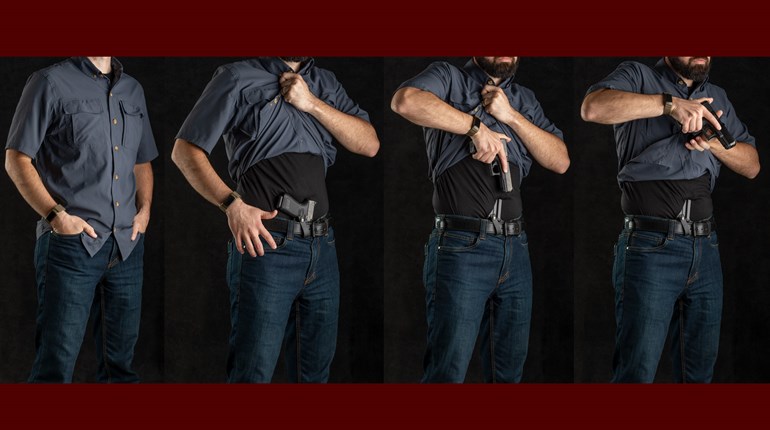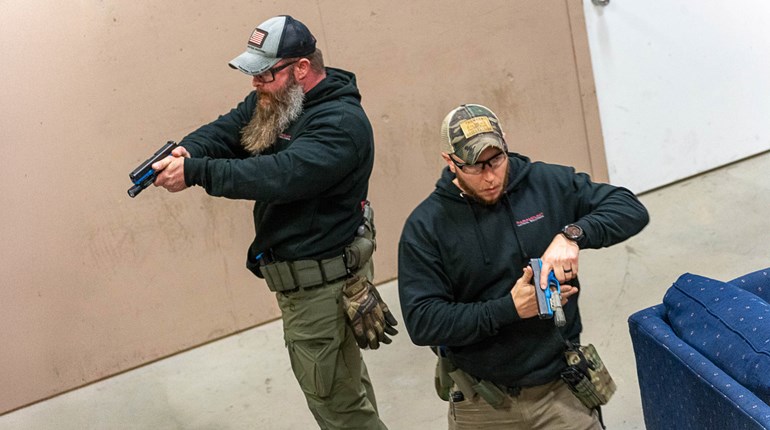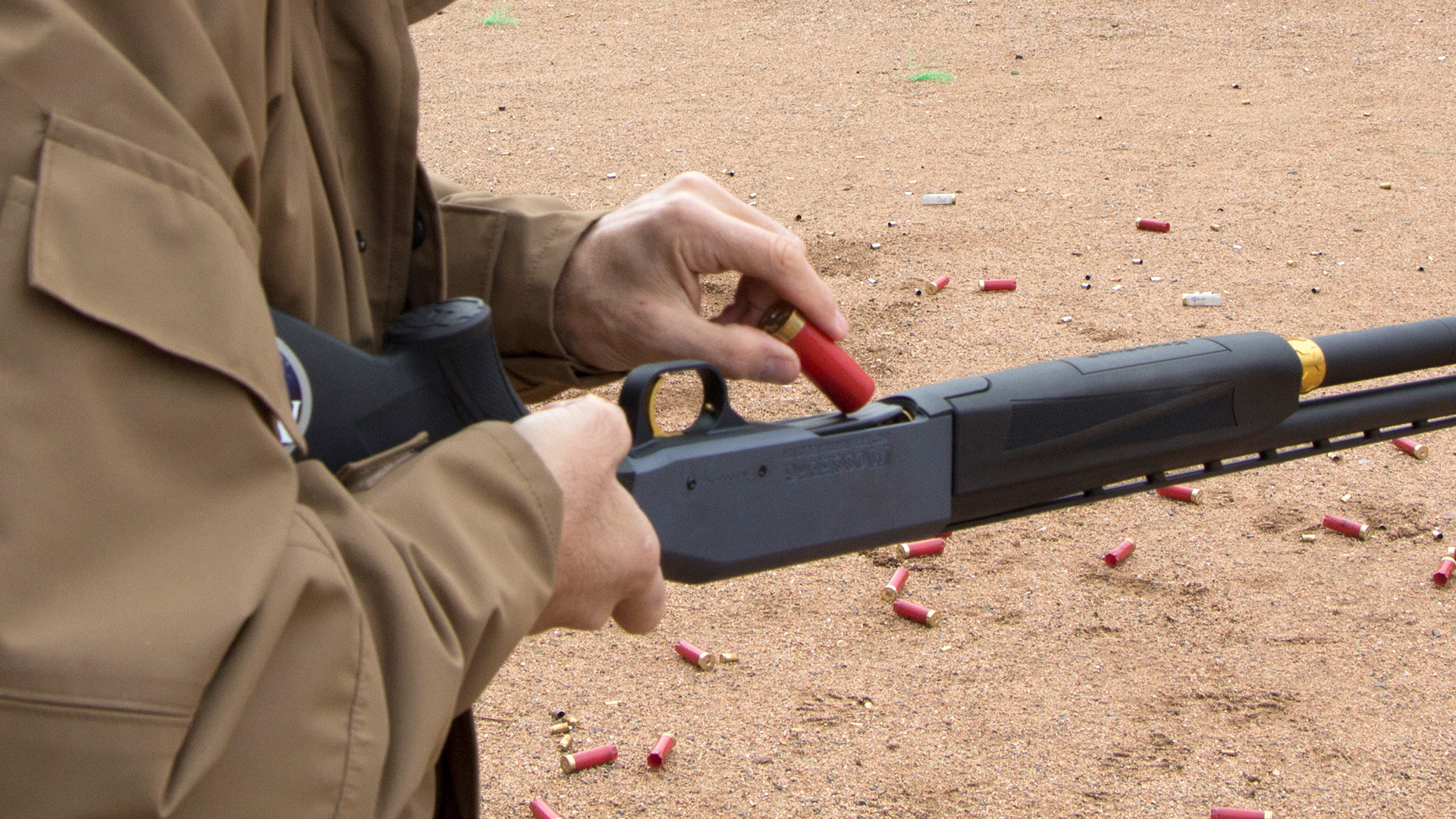
It’s amazing how the pairing of two simple words can cause such mental anguish in the decision-making process, as in “concealed carry.” You’ve decided to carry a gun, and you know you must keep it concealed. Despite the number of concealed-carry holster options available in today’s market, choosing one (or more likely two,) shouldn’t be difficult. Your lifestyle and your wardrobe will largely determine what you can or can’t use. You just have to acquaint yourself with the various options available and judge which ones would work for you in the course of a typical day. Let’s look at some, determine the pros and cons and how they might fit into your life.
We'll start with belt holsters for two reasons. First, it’s the method of carry I use most often and with which I’m most familiar. Second, and of greater importance, it’s the method most people use when attending a training class and/or practicing to hone their skills. There’s an old adage: If you find yourself in a gunfight, you are not likely to rise to a new level of performance, but rather revert to your level of training. When trouble strikes, reaching for a gun on your hip that’s actually in an ankle holster could prove fatal.
After several visits, the draw stroke taught at Gunsite Academy has become a habit with me, and while it’s not likely I’ll ever be fast, the motion has become smooth. Transitioning from drawing your pistol from an exposed hip holster to drawing one from the same holster covered by a loose outer garment adds a slight sweeping motion at the front end of the presentation, but retains every other element learned in the Academy’s basic 250 Pistol class. The training for accessing my defensive sidearm is in place; I will not need to learn something new after engaging the threat.
Whether the strong-side hip carry involves an inside-the-waistband (IWB) or outside-the-waistband (OWB) holster may slow your draw stroke a bit, but it shouldn’t change your basic technique. For an OWB, the cover garment may have to be a bit longer to properly conceal the pistol/holster depending on barrel length and how much holster extends beneath the belt. A sport coat, lightweight vest or untucked shirt all work nicely. My number-one choice is a stock Avenger-style holster from Galco or a similar style rig from Rafter-L Combat Leather. Both offer maximum comfort, quickest access and acceptable concealment. In addition, both have a cut-out area on the inside of the belt loop permitting proper location of the holster on the belt and it allows the holster to “straddle” a belt loop for additional stability.
Some IWB holsters are equally comfortable, specifically the CrossBreed IWB with its large, soft pad between handgun and body. There are no sudden jabs from the pistol’s unyielding edges. A downside to the full protective pad is the increased difficulty in getting your fingers around the gun’s handle for a proper firing grip early in the draw stroke. CrossBreed cuts away part of the pad of the holster if so ordered, and Galco offers a similar IWB rig called the KingTuk with a “combat cut” to facilitate that all-important early firing grip. Galco’s Mike Barham reports that the KingTuk has been the company’s best-seller for the last five years due its concealability and affordability.
As good as belt holsters are in most scenarios and despite being my first pick for everyday carry, they present difficulties when seated—particularly in a car with the seat belt fastened. On these occasions, shoulder and ankle holsters deserve serious consideration. If, like me, you’ve watched episodes of the TV show “Miami Vice,” you probably have a soft spot in your heart for the Galco Miami Classic shoulder holster. One realizes what a great rig this is for car travel or comfortable carry under a loose sport coat. Your physique might limit the size of the pistol (or revolver) selected, but changing the gun’s angle from horizontal to vertical carry position gives additional flexibility in firearm selection, and the off side of the harness assembly will handle a couple of wheelgun speedloaders, as well as spare magazines.
As you might imagine, the draw stroke is something less than lightning fast, but the gun is protected from both prying eyes and inclement weather. You will need to learn and practice a safe-drawing technique, because with this rig it’s easy to inadvertently point at part of your anatomy when presenting the gun. Also, be advised that training schools may not permit the horizontal carry as it violates Rule 2 and allows the muzzle to cover other students and instructors whenever you move.
Ankle holsters are another solid choice for those who are frequently in a seated position. When sitting behind a desk or at a table, the furniture will conceal your movements, allowing you to start the draw before a threat knows you’re armed.
I’m a huge fan of pocket pistols, not because they are the best potential solution to a gunfight, but because they are very flexible and incredibly forgiving of my laziness and poor planning. Going for a quick trip to the store? Put a small revolver or semi-automatic in a pocket holster and shove it in your most-accessible pocket. Many of the pocket holsters from Galco and Tuff Products will fit more than one small semi-auto or revolver. In addition, I have a pair of custom pocket holsters from Rafter-L made for J-frame revolvers and contoured to specifically fit a right- and left-hand trouser pocket, respectively. If I’m carrying a primary gun on the strong-side hip, the little revolver will go in the left-hand pants pocket. If the revolver is my only sidearm, the right-hand holster goes into a trouser, jacket or shirt pocket.
Seated in a car, restaurant or movie theater, you can move the holster from a trouser pocket to a chest pocket for easier accessibility. They’re perfect for that last-minute decision to go somewhere; just grab the pocket pistol and go. I strongly recommend you carry any pocket pistol in a holster that covers and protects the trigger and trigger guard. And never place anything but the gun and holster in the pocket you’re using. I haven’t spent much time with semi-autos as pocket pistols, but at Galco, LCP rigs are the best-selling pocket holster with LCR and J-frame holsters being second.
Accessories are worth more than a casual look. For any belt holster, Barham says, “The belt is the foundation for the carry system. It must be rigid enough to provide stability to carry the gun and ammo management devices.” Erik Little, at Rafter-L, offers a series of holster sizes and will tailor combinations to fit the shooter’s needs based on the pistol. Tell him what gun you have and which holster you’d like for it; he will make the holster to fit that gun and select a proper belt to go with it and whatever else you plan to carry on it.






































